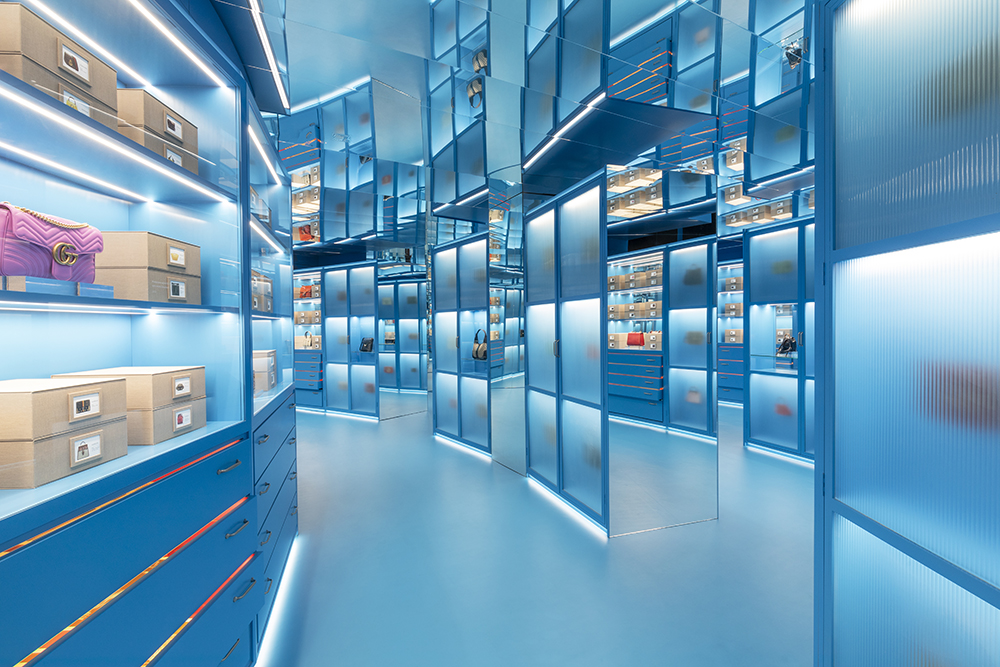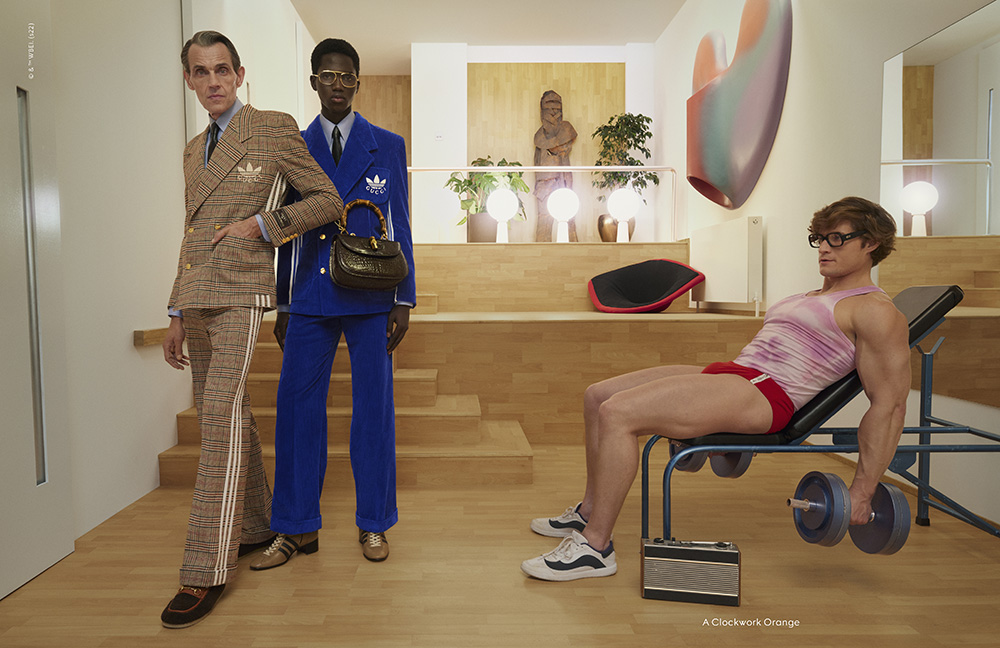Gucci is proud to present Gucci Cosmos, a cutting-edge exhibition of the House’s most iconic designs from its 102-year history. Having premiered in Shanghai in April, the itinerant global exhibition arrives in London in October, bringing its creative and immersive experience to 180 Studios at 180 The Strand. Celebrating the House’s deep ties to the UK’s capital, Gucci Cosmos takes visitors on a journey backwards and forwards through time, exploring the House’s history and its Florentine roots while writing a paean to its enduring creativity.
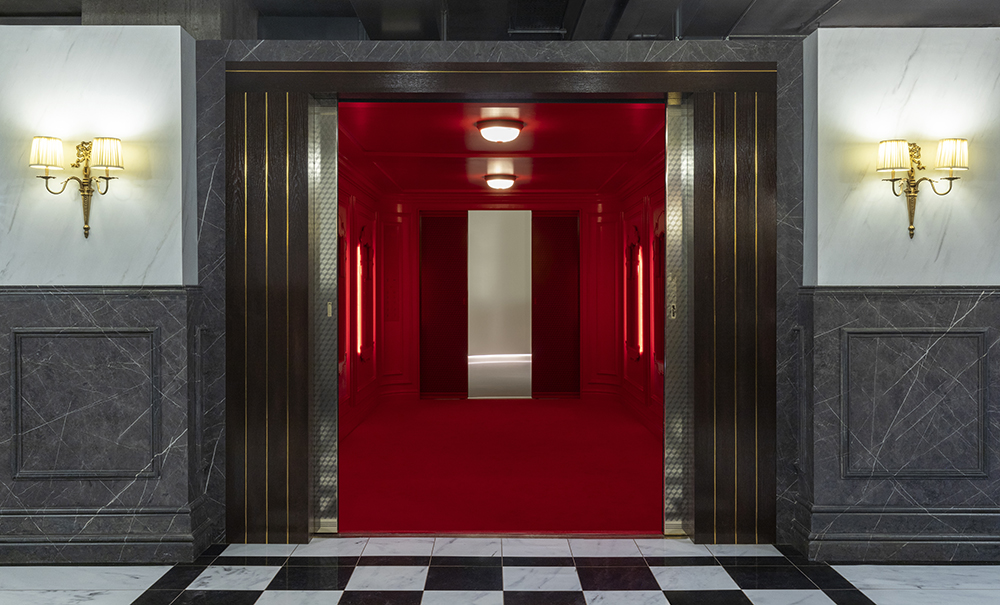
It might be said that the story of Gucci began in London in 1897 when a young Guccio Gucci took a job as a luggage porter and liftboy at the city’s exclusive The Savoy hotel. Carrying guests’ luggage through its famous revolving entrance doors and operating the lift up to the rooms and suites, the teenage Guccio encountered up close the tastes and lifestyle of the international elite, absorbing – as if by creative osmosis – new ideas, broader horizons, and more worldly cultural concerns. Inspired by these experiences, and with a new-found aspiration to make his name synonymous with the art of luggage making, Guccio returned to Florence and in 1921 founded his eponymous leather-goods house, followed by the first Gucci store on the city’s Via della Vigna Nuova. Gucci Cosmos explores how Guccio Gucci’s abiding codes and spirit have been brought to life in the House’s most iconic designs, and how these era-defining classics have forever inspired and been reinterpreted by its design visionaries. The exhibition showcases how this progressive belief in the power of creativity, anchored in the finest Italian craftsmanship and tradition, has seen Gucci not only mirror the times, but also define them – and in doing so, influence society and aesthetic tastes.

Conceived and designed by renowned British contemporary artist Es Devlin and curated by eminent Italian fashion theorist and critic Maria Luisa Frisa, this playful voyage through Gucci’s past, present and future is experienced across a series of ‘worlds’ that draw together treasures – many previously unseen – from the Gucci Archive, a living and breathing repository and working hub for the House’s creative teams, housed in the 15th-century Palazzo Settimanni in Florence. Each world traces a different aspect of Gucci, its unwavering principles since its foundation in 1921, and its ever-renewed inspirations and creativity – from the nascent ambitions of founder Guccio Gucci to the pioneering spirit of his sons Aldo and Rodolfo, and the wildly imaginative powers of more recent creative directors Tom Ford, Frida Giannini, Alessandro Michele, and now Sabato De Sarno.
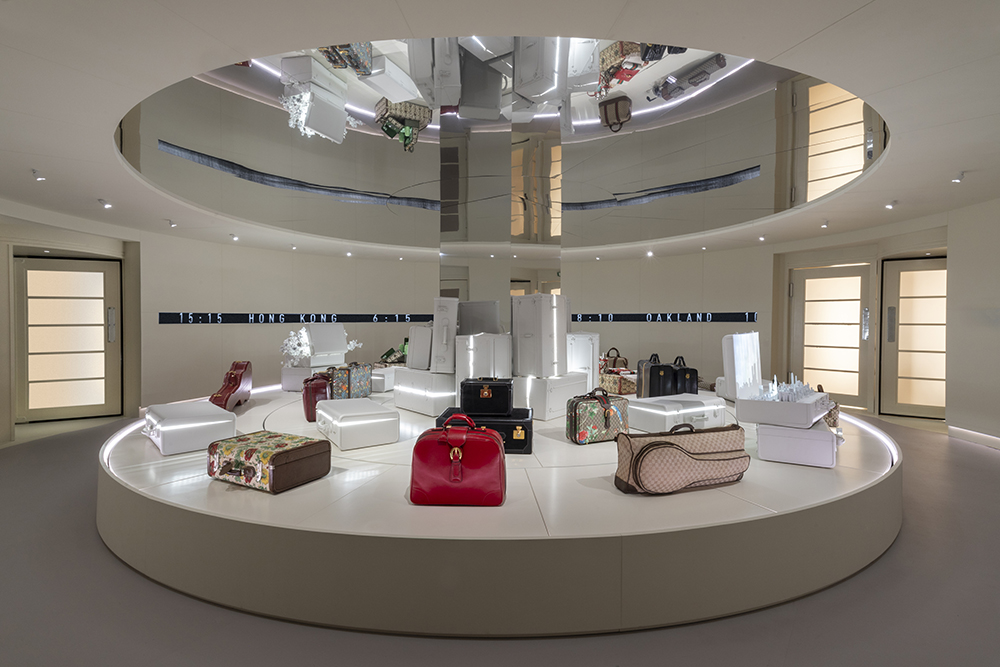
Es Devlin: “As a creative endeavour and expression of the times, the House and its history over the past century can be mapped through an ability to evolve and, more broadly, to expand on the mutability of our own consciousness and ability to make cognitive shifts. Rather like a garment itself that is able to be changed and re-tailored, like a shed skin that constantly renews itself. For the exhibition’s iteration in London, I wanted draw on the city’s pivotal role in the House’s origin myth in which a young Guccio Gucci rode up and down the red lacquered ‘Ascending Room’ at The Savoy where his interactions with guests and their exquisite luggage would go on to forge his future.”

Maria Luisa Frisa: “Gucci Cosmos, a project in the form of an exhibition inaugurated in Shanghai and now located in London, was an extraordinary opportunity for me to traverse the universe of Gucci through an ever-different lens. And I was able to tell its story through the clothes, objects, elements, people, and contexts that made this brand iconic and a trailblazer within fashion and collective visual culture for over a century. It is a challenge to work on an exhibition that evolves based on different spaces and the atmosphere of the cities that host it, and therefore demands reflection on the special connection between London and fashion, to reconfigure the relationship between the elements and the selection of objects. Gucci Cosmos is an immersive expository experience in which the origin story and history itself are continuously put to the test by the imagination of the future.”

For Gucci Cosmos in London, Es Devlin has dived deeper into the House’s long-standing ties to the British capital (her hometown), adapting the show’s design with site-specific experiences. Using a careful balance of audio, visual and kinetic components, she has begun with Guccio Gucci’s experiences at The Savoy – which sits just 500 metres from 180 The Strand – further exploring this key period in the House’s origins, which she frames around the metaphor of orbits within the Gucci universe. The exhibition conveys how the timelessness of Gucci’s visionary ethos and its gravitational pull creates and shifts meaningful dialogues and myriad correspondences between the House’s iconic designs, its creatives and artisans, and society at large.
Duomo
Before London, there was the city of Florence, birthplace of Guccio Gucci and the city where he founded his artisanal luggage atelier 102 years ago. This is why Gucci Cosmos fittingly opens by bringing a symbol of the Tuscan capital’s architectural glories to the streets of London. Attached to the ground-floor and first-floor exterior facade of 180 The Strand and mounted on a bright red and green background, ‘Duomo’ is made up of two mirror-image bas-relief reproductions of Filippo Brunelleschi’s revolutionary 15th-century dome for Florence’s cathedral, Santa Maria del Fiore.
The Gucci x The Savoy Lobby
For Gucci Cosmos in London, the lobby of The Savoy in which Guccio Gucci worked in the late 1890s has been meticulously reproduced, from its iconic black-and-white marble floor to its stylish light fittings and furniture. This entrance space, which evokes the modernity of the lobby when it first opened at that exciting time in London’s history, features a café decorated with vintage wallpaper serving red-coloured drinks and snacks, areas with comfortable seating, and rare access to the garden at 180 The Strand.
The Ascending Room
To access the main exhibition spaces, visitors enter a large-scale reproduction of The Savoy’s famous red lift, the first electric elevator in London. Unveiled in 1889 and affectionately known as the Ascending Room by its astonished visitors, who weren’t used to standing this close together in an enclosed windowless box. This remarkable invention would have been constantly used by Guccio as he escorted guests and their luggage in the lift, allowing him to hone his sensitivity, to his guests and their stories, and most of all to their luggage. The Gucci Cosmos recreation, decorated in all red like the original, whisks small groups of visitors on an ascending son-et-lumière journey, telling the story of how those seven-minute journeys up and down the hotel would one day inspire the founding of an artisanal luggage atelier.
Portals
Visitors leave the 19th-century atmosphere of ‘The Ascending Room’ and return to the present day in a minimalist white space with a staircase that leads down to the first of Gucci Cosmos’s worlds, ‘Portals’. Continuing the story of the House’s founding father, Guccio Gucci, and the ongoing resonances for the House of his time at The Savoy, ‘Portals’ consists of three, all-white, interlocking circular installation spaces linked by a series of revolving doors – a nod to the hotel’s original entrance. The spaces feature moving, circular conveyor belts, carrying examples of Gucci’s most exquisite luggage designs from across the decades. These include one of the earliest signature suitcases designed by Guccio in the late 1920s, cases and other travel accessories featuring a distinctive GG-print canvas that was created by Aldo Gucci in the 1960s as an homage to his father, and Disney-print luggage from the Epilogue collection, designed in 2020 by Alessandro Michele as a sophisticated pop-culture remix. With its constantly rotating display and soundtrack of ticking clocks and the names of different cities around the world, this principal ‘Portals’ space and its mirrored ceilings embody the interchange of design knowledge, ideas, and inspirations between the different Gucci creative directors. It highlights how each has tapped into the soul of the House in order to rework it and reveal its essential modernity. Both this principal space and the two smaller adjoining spaces also feature multimedia dioramas, each placed inside a different piece of Gucci luggage and inspired by cultural icons from Gucci’s past and present including Jacqueline Kennedy Onassis, Princess Grace of Monaco, and Diana, Princess of Wales as well as an homage to la–dolce-vita-era Rome and its ability to captivate the international jet set and Hollywood stars alike. Leaving the ‘Portals’ world, visitors cross an area that illustrates the evolution of the double GG logo since its creation by Aldo Gucci as an homage to his father, Guccio.
Zoetrope
Gucci has long drawn inspiration from the equestrian world, a connection celebrated in Gucci Cosmos’s ‘Zoetrope’ world. Its circular space is punctuated with immersive large-format screens presenting evocative video footage accompanied by a soundscape of galloping hooves and a voice that recites equestrian-inspired words to the equine rhythm. Multiple archival pieces demonstrate how the House’s different equestrian icons have fired the imagination over time, such as the Horsebit, with its double ring and bar, which became a distinctive element of the House in 1953 when Aldo Gucci introduced it on the iconic loafer, and the signature green-red-green Web stripe, inspired by the strap that holds a horse’s saddle in place. Visitors follow the Horsebit hardware from the original loafer presented in a version from the early 1960s, a 1960s belt, a 1970s wool and suede dress, and a new platform loafer worn with an all-over Web precious leather jacket and culottes from Sabato De Sarno’s debut Spring Summer 2024 collection. ‘Zoetrope’ also demonstrates how the House’s creative directors have playfully subverted equestrianism’s traditional aristocratic practices, with examples including a Tom Ford-designed riding crop and Horsebit black leather corset by Alessandro Michele.
Eden
‘Eden’, the next world in Gucci Cosmos, brings to life the tale of Flora, an exquisite and delicately naturalistic image of plants and fauna from 1966. Commissioned by Rodolfo Gucci from acclaimed Italian artist and illustrator Vittorio Accornero de Testa for a silk scarf created for Princess Grace of Monaco, it became the leitmotif for Gucci’s 1981 ready-to-wear collection, presented in the Sala Bianca, in Florence’s Palazzo Pitti and has since ignited the artistry of Tom Ford, Frida Giannini, Alessandro Michele and Sabato De Sarno. Within the light- and mirror-filled circular space of ‘Eden’, with its feeling of being inside the vaults of a Florentine palazzo, Gucci’s ongoing relationship to the diversity and beauty of the biosphere is symbolized in an installation of larger-than-life white sculptures of flowers and insects featured in Accornero’s design. These are suspended above key archive pieces that reveal Flora’s constant ability to inspire. Embodying how the elegant pattern has been used, reused, and remixed are a gloriously hypnotic Flora-print silk minidress from 1969, a 2008 Frida Giannini floral print dress created for a Gucci Flora fragrance campaign, Alessandro Michele’s signature embroidered shearling-lined denim jacket with its ‘L’Aveugle Par Amour’ motto, a floral print ‘Jackie’ bag from Spring Summer 1999 by Tom Ford, and a series of silk scarves and fabric bags. The visitor is accompanied through ‘Eden’ by a soundtrack of brushstrokes, water drops, and a voice reciting all the different colours featured in the Flora design, as if it were Accornero talking to himself as he painted.
Two
Leaving ‘Eden’, visitors enter ‘Two’, a stunning space in which a pair of monumental 10-metre-tall white statues hover just above the floor. Lying on their sides, like guards at a long-lost ancient temple, the statues’ ‘blank canvases’ feature a mesmerizing loop of projections of images of men’s and women’s suits from Gucci’s past and present, which symbolize the House’s trailblazing belief in unisex fashion and its ability to shift societal ideas and behaviour. These include the celebrated red velvet suit created for both men and women by Tom Ford in 1996; a striking Frida Giannini-designed checked suit with cinched waist; and designs by Alessandro Michele, such as his sparklingly floral unisex versions from 2016 and one from his ‘Twinsburg’ collection, shown in 2022. Accompanying the constant evolution of clothing on the statues, the rest of the room is projected with skyscapes suggesting the infinite, while the soundtrack features a poem written and recited by Es Devlin exploring the concept of our bodies as multitudes.
Archivio
To enter the ‘Archivio’ world of Gucci Cosmos is to explore the origins of the House’s most iconic bags in a breathtaking space with a mirrored ceiling that creates a feeling of infinity. This maze-like world is reminiscent of the Gucci Archive in Florence and has walls lined with a multitude of cabinets and drawers. The historic bags on display include those now considered modern, yet timeless classics: the Bamboo 1947, the Jackie 1961, the Horsebit 1955, the Gucci Diana, and the Dionysus. The versions within the ‘Archivio’ world encompass a rare and colourful 1960s hemp interpretation of the Guccio Gucci-designed Bamboo bag, alongside a revisited leather version from the 1990s; an early example of the Jackie bag, featuring its signature piston clasp and Web stripe, as well as a late-1970s update featuring the legendary GG pattern. Also on show are a red leather bamboo-handle tote from the early 1990s that Alessandro Michele reimagined as the Gucci Diana in 2020, and two bags bearing the GG logo: an early-1970s style in black leather defined by its rounded version of the signature Interlocking G emblem, which inspired the Gucci Blondie first presented in 2021, and the debut GG Marmont in white matelassé leather, designed by Alessandro Michele in 2016. Rounding out the selection are handbags by Sabato De Sarno for Spring Summer 2024 including a Jackie Notte, a bucket bag with snap-hook closure and Web strap, and a patent leather Bamboo 1947 – all in the new signature Rosso Ancora shade of red. Alongside the cabinets, visitors can continue their archive dive by exploring drawers containing reproductions of illustrations by Vittorio Accornero de Testa, artisans’ sketchbooks and technical drawings, and vintage advertising campaigns.
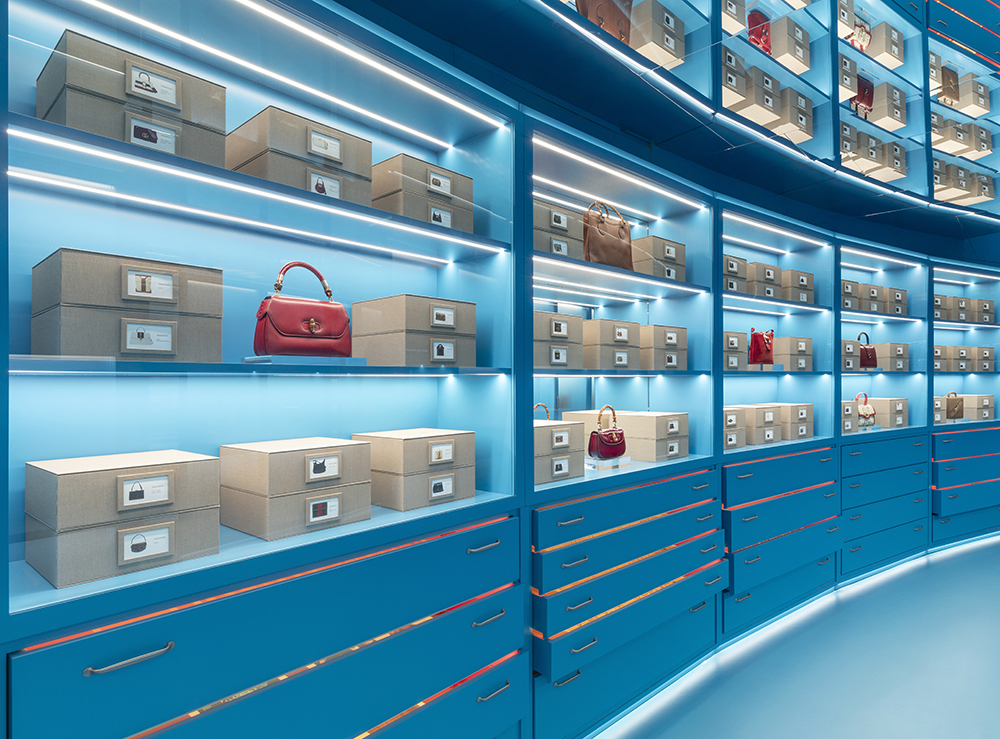

Cabinet of Wonders
At the centre of the circular ‘Cabinet of Wonders’ world sits a rotating cabinet of curiosities. Three metres high, this stunning monolithic cube covered in deep red lacquer is filled with drawers and compartments that mechanically slide in and out – accompanied by a sound installation that accentuates and multiplies the sound of the cabinet’s mechanical movements – to reveal a wildly eclectic collection of garments, accessories and curios. Showcasing the full breadth of the House’s design range, it contains everything from a Tom Ford 2001 collection look with a black leather bustier to a 2006 Frida Giannini golden evening gown and GG velvet bag with metal and rhinestone handle, as well as a punk-inspired spherical leather bag with metal spikes from 2019 by Alessandro Michele and a crystal-embellished Jackie Notte bag from 2023 by Sabato De Sarno. Also present is a selection of singular jewellery spanning over six decades all the way to pieces from Sabato De Sarno’s recently-unveiled Marina Chain collection inspired by iconic archival styles from the late 1960s, alongside animal-shaped metal objects from the early 1970s inspired by the English countryside, and a Tom Ford-era electric guitar. The room also features a look worn by Harry Styles from Coachella 2022, an outfit worn on the Met Gala red carpet by Sinéad Burke, and a lamé bomber inspired by a stage look worn by Sir Elton John reinterpreted by Alessandro Michele for his Spring Summer 2018 collection. Like a symbol of Gucci’s free-spirited heart, ‘Cabinet of Wonders’ is a testament to the House’s unending flair for transforming the unexpected into objects of beauty and for audaciously following wherever inspiration may lead.


Carousel
In ‘Carousel’, a parade of 25 mannequins wearing Gucci clothing from the 1970s to the present-day glide smoothly by, like fashion models on an ever-moving catwalk, accompanied by an atmospheric soundtrack of sewing machines and atelier noises. By arranging these full looks – each from a specific season – not by chronology but by colour and inspiration, ‘Carousel’ opens up entirely new connections, like a dance across time, and underlines the House’s ongoing creative conversation with its own values, heritage, and modernity, and its fundamental belief that fashion can drive both aesthetic and social change. A 1970s silk shirt and skirt with a G cube motif speak to the trompe l’oeil ribbon on an elegantly playful 2016 wool cape by Alessandro Michele; a silk dress with feathers and the delicate swish of a chain-embroidered flapper dress from 2012 by Frida Giannini play off the hedonistic and seductive glamour of Tom Ford-designed unisex suits from 1996. These myriad dialogues are given further resonance with the presence of three looks from Sabato De Sarno’s debut Spring Summer 2024 collection featuring bold outerwear, crystal-embellished details, and leather pieces in the new signature Rosso Ancora shade of red. As the looks rotate around the conveyor belt, newly commissioned illustrations by four UK-based artists including Nuria Boj, Alexis Deacon, Joshua Donkor and Steve Harrison and by four selected Chinese artists including Victo Ngai, Vikki Zhang, Li Jianmei, and Currynew – originally for the exhibition’s Shanghai edition – are projected onto a gauze screen surrounding the looks to create a multi-layered globetrotting vision that forges further dialogue and strengthens the creative ties across continents.
Gucci Ancora
With ‘Gucci Ancora’, visitors enter a room directly inspired by Creative Director Sabato De Sarno’s debut collection and runway show for the House. Decorated entirely in the new signature Rosso Ancora shade of red, the room features a central semi-transparent parallelepiped structure containing screens within a mirror-clad inner chamber. Projected onto these semi-transparent walls is a series of personal memories, phrases, and other fragments in both Italian and English, their words appearing and disappearing in mesmerizing motion, accompanied by an evocative video and sound installation featuring the voices of Es Devlin and Sabato De Sarno. To underline the space’s core aesthetic of installation art merging with poetry and stories, the perimeter walls of ‘Gucci Ancora’– ancora is an Italian word that means ‘also now, again, one more time’ – are lined with semi-transparent cards featuring words that visitors can move around to create their own compositions.
Ultimately, Gucci Cosmos is an experiential incarnation of the Gucci soul, from its origins in 19th-century London to its foundation in Florence and its fruitful growth around the world. It is a tribute to the House’s most iconic designs, symbols and products, and the exceptional talents of its designers and artisans. From Guccio Gucci in 1921 to today, all have ensured – and continue to guarantee – that Gucci will forever remain at the pinnacle of creativity and Italian craftsmanship, a global House committed to genuine luxury quality, iconic designs, and ideas that shape the future.
Gucci Cosmos opens at 180 Studios, 180 The Strand, in London, on 11 October and runs until 31 December 2023.

